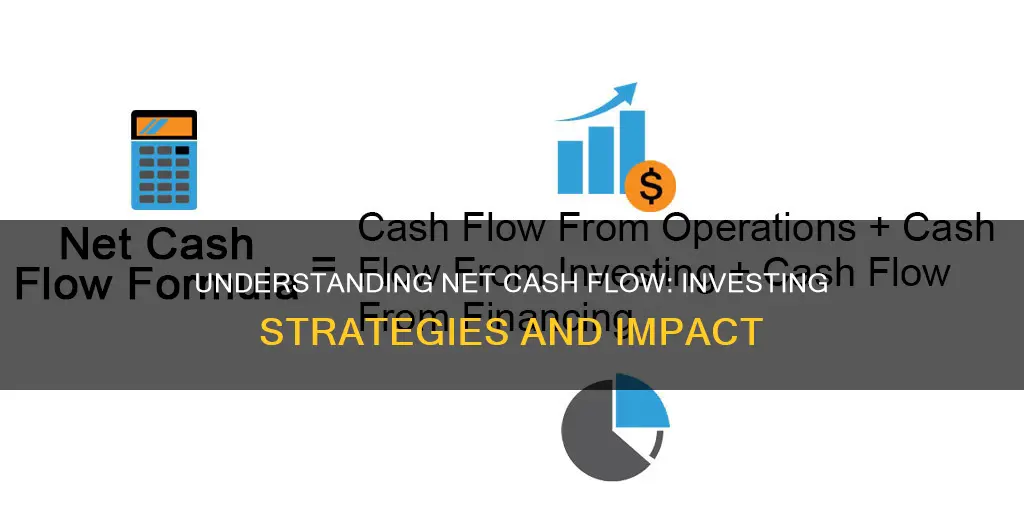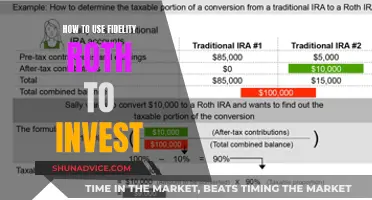
Net cash flow is a profitability metric that represents the amount of money produced or lost by a business during a given period. It is the difference between the money coming in and the money going out. Net cash flow from investing activities is one of the sections of a company's cash flow statement. It reports how much cash has been generated or spent from various investment-related activities in a specific period. This includes purchases of physical assets, investments in securities, or the sale of securities or assets.
What You'll Learn

Capital generated from profitable investments
Net cash flow is a profitability metric that can be used to gain insight into the financial health of a business. It represents the amount of money produced or lost by a business during a given period and is calculated by working out the difference between a business's cash inflows and outflows.
Net cash flow is comprised of three categories: operating activities, financial activities, and investing activities.
Investing activities include the purchase of physical assets, investments in securities, or the sale of securities or assets. These investments can be made to generate income or as long-term investments in the health or performance of the company.
Some examples of investing activities include:
- Purchase of property, plant, and equipment (PP&E)
- Proceeds from the sale of PP&E
- Acquisitions of other businesses or companies
- Proceeds from the sale of other businesses
- Purchases of marketable securities (e.g. stocks, bonds)
- Proceeds from the sale of marketable securities
When evaluating investing activities, it is important to consider the long-term goals of the company. Negative cash flow from investing activities may not always be a bad sign, as it can indicate that management is investing in the long-term health and growth of the company. For example, investing in research and development may lead to short-term losses but could result in significant growth and gains in the future if those investments are managed well.
Additionally, capital investments can provide benefits such as increased productivity, higher-quality goods, cost savings, and a competitive advantage in the market. However, there may also be short-term downsides, such as reduced earnings growth and additional operating expenses.
Overall, capital generated from profitable investments is an important aspect of net cash flow, and it is crucial to consider both the short-term and long-term impacts of these investments on the financial health of the business.
Warren Buffet's Strategy for Investing Berkshire's Cash Reserves
You may want to see also

Cash spent on making investments
Investing activities include purchases of physical assets, investments in securities, or the sale of securities or assets. These investments can be made to generate income or they may be long-term investments in the health or performance of the company.
For example, cash spent on investing activities could include:
- Outflow: purchase of property, plant, and equipment (PP&E), also known as capital expenditures
- Outflow: purchase of marketable securities
- Outflow: acquisitions, net of cash acquired
- Inflow: proceeds from the sale of property and equipment
- Inflow: proceeds from the sale of marketable securities
A negative cash flow from investing activities is not necessarily a bad sign. It could indicate that management is investing in the long-term health of the company. For example, while investing in new machinery or real estate may lead to short-term losses, the investment could make the business more money in the future.
Therefore, it is important to look at the context of the business's financial situation when considering cash spent on making investments.
Cash App Investing: How to Make an Investment Request
You may want to see also

Cash generated from selling assets
Net cash flow is a profitability metric that indicates the amount of money a business has generated or lost during a given period. It is calculated by subtracting the total cash outflows from the total cash inflows. Net cash flow is divided into three categories: operating activities, financial activities, and investing activities.
Investing activities include the purchase and sale of physical assets, investments in securities, or the sale of securities or assets. These can be long-term investments in the health or performance of the company, or they can be made to generate income on their own.
Now, let's focus on the cash generated from selling assets. When a company sells its assets, it can result in a positive cash flow. This is because the company receives cash in exchange for the sale, leading to an increase in cash flow. Even if the asset is sold at a loss, the cash received from the sale will still result in a positive cash flow.
For example, if a company sells a piece of equipment for $10,000 but originally purchased it for $15,000, it would have a positive cash flow of $10,000 from this transaction. This is because the company is bringing in $10,000 in cash, even though it incurred a loss on the sale.
The proceeds from the sale of assets are included in the investing activities section of a company's cash flow statement. This section displays the cash generated from or used for making investments during a specific time period. It includes the sale of physical assets, such as property, plant, and equipment, as well as the sale of investments such as stocks or bonds.
The cash generated from selling assets is an important component of a company's cash flow statement as it provides insight into the total investment gains and losses incurred during a specific period. It also reflects the company's efforts to generate positive cash flow and improve its financial health.
In summary, the cash generated from selling assets contributes to the investing activities portion of a company's cash flow statement and can result in a positive cash flow, even if the sale incurs a loss. This aspect of net cash flow is crucial for understanding a company's financial health and its ability to generate cash from its investments and asset management.
Shareholder Cash: Is It a Company Asset?
You may want to see also

Cash spent on purchasing assets
Net cash flow is a profitability metric that represents the amount of money produced or lost by a business during a given period. It is calculated by working out the difference between a business's cash inflows and outflows. One of the three categories that make up net cash flow is investing activities, which includes cash spent on purchasing assets.
Investing activities are one of the sections of a company's cash flow statement, reporting how much cash has been generated or spent from various investment-related activities in a specific period. This includes the purchase of physical assets, investments in securities, or the sale of securities or assets.
Physical assets can include property, plant, and equipment (PP&E), also known as capital expenditures. These are long-term assets that will deliver value in the future. PP&E is a large line item on the balance sheet, and investors and analysts can refer to the investing section of the cash flow statement to understand how much a company spends on it.
Capital expenditures (CapEx) are a popular measure of capital investment used in the valuation of stocks. An increase in capital expenditures means the company is investing in future operations. However, these expenditures are a reduction in cash flow. Companies with significant capital expenditures are typically in a state of growth.
Other investing activities that can appear on the cash flow statement include:
- Purchase of fixed assets
- Purchase of investments such as stocks or securities
- Sale of fixed assets
- Sale of investment securities
- Collection of loans and insurance proceeds
Negative cash flow from investing activities does not always indicate poor financial health. It often means that the company is investing in assets, research, or other long-term development activities that are important for the health and continued operations of the company.
Gross PPE Cash Flow: Investing Strategies for Success
You may want to see also

Net cash flow from investing activities formula
Net cash flow from investing activities is one of the three sections of a company's cash flow statement, alongside cash flow from operations and cash flow from financing activities. It reports how much money has been spent or generated from investment activities in a specific period.
Formula
There is no single agreed-upon formula for calculating net cash flow from investing activities. However, a generally accepted formula is as follows:
> Net cash flow from investing activities = CapEx/purchase of non-current assets + marketable securities + business acquisitions - divestitures.
Here, divestitures refer to the sale of investments.
Example
Let's consider an example to understand how to calculate net cash flow from investing activities.
Suppose a company spent $30 billion on capital expenditures, $5 billion on investments, and $1 billion on acquisitions. Additionally, the company earned $3 billion from the sale of investments. To calculate the net cash flow from investing activities, we sum up these amounts to get a total of -$33 billion.
This negative value indicates that the company had a net outflow of cash from its investing activities during the period. It does not necessarily indicate poor financial health, as it could be investing in long-term assets or research and development, which may lead to significant growth in the future.
Cash Investment: Asset or Liability?
You may want to see also
Frequently asked questions
Net cash flow from investing activities is the section of a company's cash flow statement that shows the cash generated by or spent on investment activities. It includes purchases of physical assets, investments in securities, or the sale of securities or assets.
To calculate net cash flow from investing activities, you need to add together both positive and negative investing activities listed on the cash flow statement.
Investing activities can include the purchase of fixed assets, the purchase of investments such as stocks or securities, the sale of fixed assets, and the sale of investment securities.







